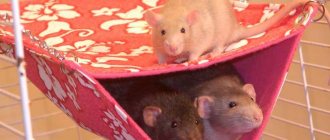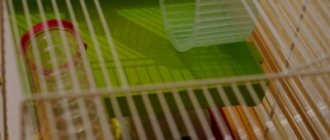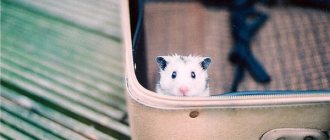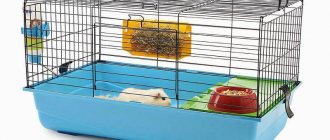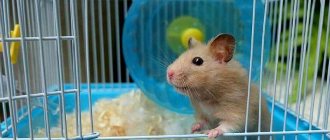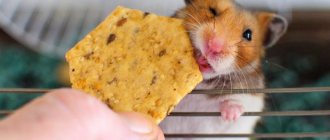A paper hamster folded using the origami technique fully corresponds to the concept of “kawaii” that is fashionable today. The term was introduced into global culture by the Japanese, who first used it in the 1960s to describe adorable children's animal toys. Hamsters, according to the inhabitants of the Land of the Rising Sun, are super-kawaii, that is, “pretty,” “tiny,” “causing a desire to protect and snuggle.” In 2021, Japan is gripped by a rodent craze known as Hamuketsu. Fans take pictures of... hamster tails and post them on social networks or send them to each other for admiration. Such pictures are considered an effective anti-stress. Probably, three-dimensional hamster figurines, also made with love, will have an even stronger positive impact.
Friendly family
In nature, hamsters are not particularly favorable towards their fellow creatures and fiercely defend their territory from “strangers” of their species. Pets are less aggressive; for example, dwarfs often live in large families if the cage is spacious and the conditions are favorable. But if real hamsters’ peaceful mood can change at any moment, paper animals will definitely not start fights. You can make a gift for a large family, because among the Chinese and Japanese, for example, small rodents symbolize home comfort and tranquility in family affairs.
For one hamster you will need a square of 15x15 cm or 10x10 cm.
Step-by-step instruction:
- We start from the underside of the sheet. Combine the far right point with the left one. We outline the diagonal. We open the product.
- Raise the lowest point to the top.
- It turns out to be a triangle.
- Bend the top of the first layer down about ¼.
- Turn the workpiece over to the reverse side.
- We fold the lower corners - right and left, as shown in the diagram.
- We bend the side triangular flaps in half.
- We make a “valley” fold along the central axis.
- Rotate the figure 90° clockwise. On the left side we bend the upper corner, on the right side we lift the triangular valve indicated by the arrow.
- We cut it in the center with scissors - we get “ears”.
- Using a “reverse fold,” we bring the corner on the left inside the figure and bring it out, making a “zigzag.”
- We also turn out the tip of the “nose”, repeating the same steps as for the “tail”, only without the zigzag.
Having mastered this model, you can try to build a more complex and realistic one using a detailed video tutorial:
How to do it yourself?
At home, anyone can make homemade interesting toys for their pet.
Crafts from nuts
You can easily make an interesting toy from walnut shells. For work you need to prepare the following items:
- nuts with whole shell;
- hammer;
- nail;
- rope;
- metal washer.
Let's look at the step-by-step execution of the work.
- Walnuts must be carefully split into two halves, but they must remain whole. You can treat your rodent to the core; such a delicacy will be not only tasty, but also healthy for him.
- Prepare a piece of rope that fits the size of the cage (consider its height). The rope must be strong.
- Using a hammer and nail, make a hole in the center of each shell.
- Tie a washer to the edge of the rope.
- Next, string the peeled nut halves onto it.
- Be sure to leave some room to securely attach the toy to the top bar of the cage.
You can improve this product if you put the animal’s favorite treats in the shell. As you can see, to manufacture the structure you need available materials and very little time.
Sleeve toy
The cardboard rolls left over from kitchen paper towels can be used to create a simple yet fun toy.
Very simple model for children
Starting from 6–7 years old, a child is able to independently master simple origami models. And one of the first things he will definitely want to do is a hamster, because it is a popular pet. To realize your creative idea, you will need a 10x10 cm square, colored pencils or watercolors and a marker.
Step-by-step instruction:
- Fold the square from top to bottom.
- Divide the resulting rectangle into three parts. Bend it 2/3 way.
- Fold the lower left corner along the dotted line.
- Using the reverse fold, we bring it inward.
- Rotate the lower right corner.
- We do the same with the left one.
- We form another reverse fold at the top right.
All that remains is to draw colored spots with paint, and also use a marker to draw the hamster’s face.
Varieties
All toys that are chosen for pet rodents are aimed at two tasks:
In some products, these two purposes can be successfully combined. It is worth noting that the treat for the hamster is safely hidden. To get to a tasty treat, you need to go through a maze or cope with a tricky structure. The smell of food is an additional incentive to go through the maze or perform other actions.
Other products that do not hide food are considered exercise equipment. The most common toy of this type is the running wheel.
Source
Bulk Djungarian hamster
Using the “Water Bomb” pattern, you can make a three-dimensional origami hamster figurine. The round paper animal is very reminiscent of the “jungarik”. This breed belongs to the miniature variety and is considered the second most popular after the Syrians. Assembling the “Water Bomb”, familiar from childhood, will not be difficult; the only difference from the classic model is that you will need to form the ears and paws of the animal.
You can “treat” the dzhungarik with origami fruits or vegetables:
And this origami hamster from the famous master Katsuta Kyohei seems just the height of kawaiiness:
Peculiarities
In natural conditions, rodents are constantly moving. In this way they protect themselves from predators and look for food. Hamsters living indoors must also constantly move to maintain physical fitness. An active lifestyle is also necessary for the excellent mood of pets.
The animal must have several toys. The cost of some of them can be high, in this case you can collect available materials and please your pet with interesting crafts. The number of toys can be any, the main thing is that there is enough free space in the cage. It is best to make several different products.
Interesting Facts
Hamsters are cautious and secretive animals; they prefer solitude and are especially active at dusk. In nature, they leave their burrows before sunset and return when it gets completely dark. They form pairs only to have offspring. The newborns are nursed by the female, while the “biological father”, having fulfilled his purpose, goes in search of a new passion.
The most popular domestic hamsters are Syrian hamsters; in nature they are on the verge of extinction due to ill-conceived human economic activity. Until 1930, they were considered an extinct species, however, Palestinian zoologist Israel Aharoni managed to discover a female with eleven cubs during a trip to the Middle East. They became the ancestors of all domestic Syrian hamsters.
It is equally interesting to know that:
- The hamster subfamily includes 7 genera, which, in turn, are divided into 19 species. Among them, only 5 are able to adapt to captivity. This is the Campbell and Roborovsky hamster, as well as the Chinese, Djungarian and Syrian.
- In their cheek pouches, the animals carry reserves equal in mass to themselves.
- Translated from German, hamster – hamstern translates as “hoard.” Even rodents born and raised in captivity tend to make large reserves, although they are not in danger of starvation.
- Hamsters have poor eyesight and color blindness, but they have a keen sense of hearing and smell.
- The wheel is an extremely important accessory for a hamster cage. Animals vitally need movement, because in the wild they run up to 12 km per day. The wheel should be plastic, solid, so that the animal’s paws do not get stuck when moving. And tall, otherwise the hamster's back will bend unnaturally, which will lead to arthritis.
- Animals' teeth are constantly growing - they need to be ground down to avoid injury. Special devices for this or, for example, a piece of wood are placed in the hamster house. Rodents often sharpen their teeth on the bars of cages, and owners mistakenly think that this is an attempt to escape.
- Pet hamsters are illegal in Vietnam, Australia, California and Hawaii. Local authorities fear that if the rodents accidentally escape, they will begin to multiply rapidly in the wild. Thereby harming agriculture and the regional biosphere.
Syrian hamster made from origami paper
Prepare a square piece of paper that is orange, yellow or brown on one side and white on the other. Start working from the colored side.
Step-by-step scheme:
- Fold the sheet diagonally and unfold it.
- Fold diagonally in the other direction, unfold.
- Fold the lower right corner towards the center point.
- Open the fold.
- Connect the upper left corner to the lower right.
- Fold the corner of the top layer towards the center of the edge and unfold this fold.
- Bend the corner of the top layer a quarter up. Make a fold along the nearest line.
- Rotate the workpiece counterclockwise 90 degrees.
- Raise the bottom corner, going beyond the center line.
- Rotate the workpiece counterclockwise 90 degrees.
- Fold the corner of the top layer up to the right.
- Fold the resulting flap in half to the left.
- Unfold the folds in steps 9-12.
- Repeat steps 9-12 on the opposite corner.
- Open the workpiece on the right. The folds indicated by the arrows should be a mountain.
- Bring small folds inward.
- Connect the folds from step 15.
- Iron the fold, press both edges.
- Open the right side.
- Take out a small fold.
- Fold it in the opposite direction - make a valley a mountain and vice versa.
- Reassemble the element.
- Fold the left side the same way.
- Fold the workpiece in half lengthwise into a mountain.
- Move the small diamonds forward.
- Fold the right side to the left diagonally.
- Open the workpiece to the condition in step 23.
- Lift the triangle of the bottom layer up.
- Rotate the workpiece counterclockwise 90 degrees.
- Fold the workpiece into a mountain along oblique lines.
- Fold in half again.
- On the right is the face of a hamster. Place the oblique folds inside the second layer on both sides.
- Bend the sharp corner on the right inward, forming a nose.
- Turn in the bottom corners on the outer layers.
- Make an internal fold in the back area, rounding the silhouette.
- Straighten your ears.
- The hamster is ready.
Editorial Voice
Irakli
Lord of Paper Sheets
Ask a Question
The Syrian hamster was once considered an extinct animal. In 1930, Palestinian zoologist Israel Aharoni discovered a female and eleven cubs in the Middle East. They became the ancestors of modern domestic animals.
Video tutorial on folding a voluminous hamster:
In wild nature
Almost all types of hamsters live in steppes and semi-deserts. Water obstacles are very rarely encountered on their path. Therefore, nature did not endow them with the ability to swim well. They do not have webbed feet, like all waterfowl. Fur does not have water-repellent properties and gets wet quickly. Nevertheless, in extreme situations, when you need to escape from an enemy or a fire, or there is a flood, all rodents float quite well on the water. The hamster swims, although poorly and not for long. The fur coat quickly gets wet and becomes too heavy. The rodent may become ill from hypothermia or die from stress.
Wild hamsters are stronger and more aggressive than their domestic relatives. In their natural habitat, they fight for their lives, and only the fittest survive. Decorative animals are more delicate and weaker. They require certain conditions of detention and get sick more often.
So the answer to the question about the buoyancy of hamsters is clear. They know how to swim, but swimming is strictly contraindicated for them.
